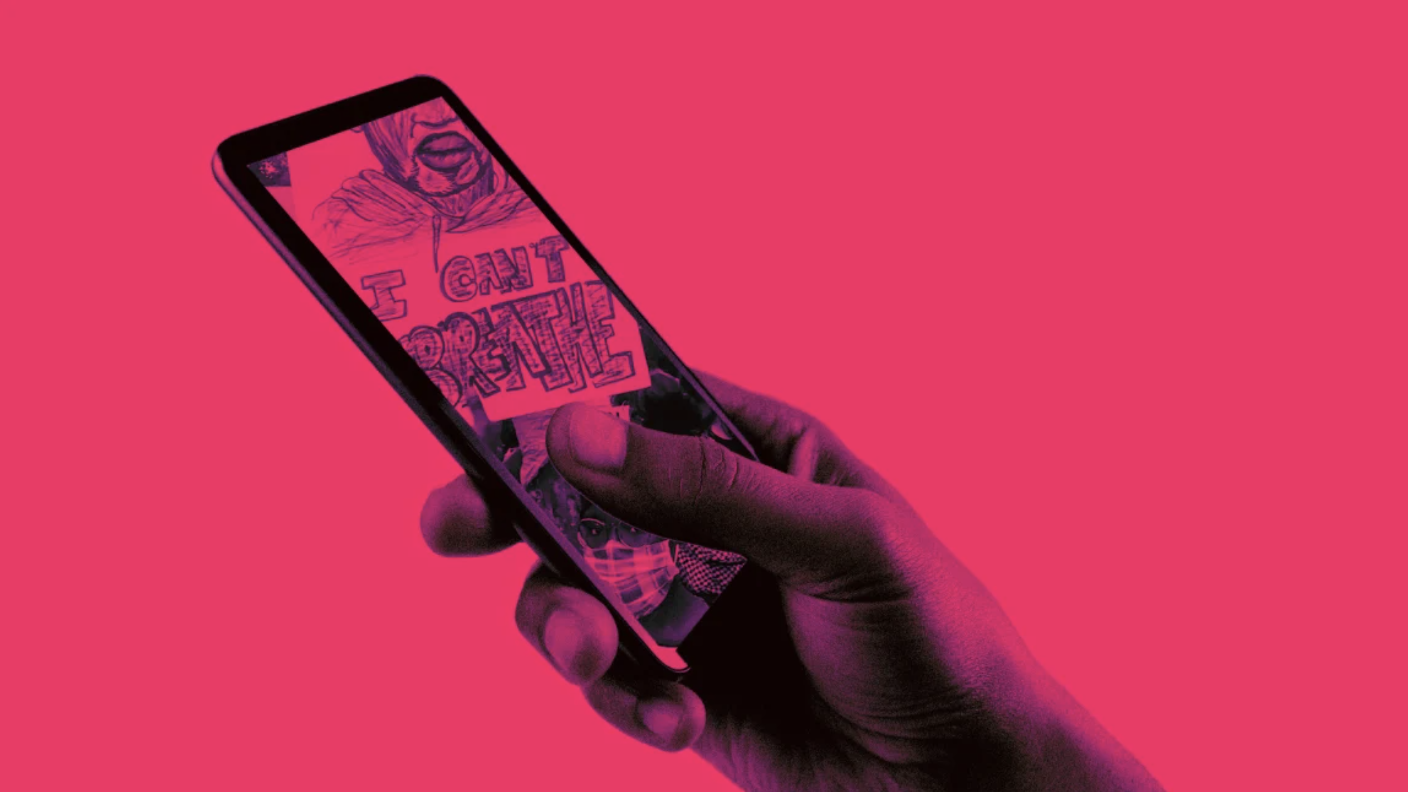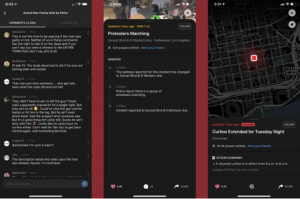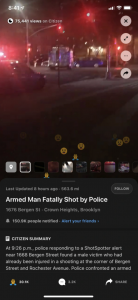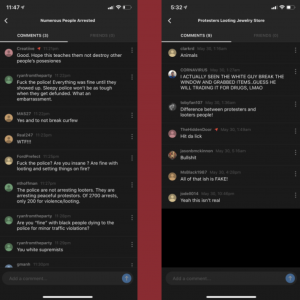Why Citizen has become the unofficial social network for protests

The George Floyd demonstrations have made the police scanner app into an overnight hit. But it’s unclear whether the app is helping people stay safe or stoking their fears.
One of the most popular ways to keep track of protests has nothing to do with Facebook or Twitter.
Instead, it’s an app called Citizen, which has become an instant hit amid nationwide protests against police brutality and racial injustice. On Citizen, users can see a map of exactly where people are gathering, view raw video of demonstrations in progress, look for signs of rioting and looting, and air out their feelings in comments sections.
Citizen currently ranks 11th in popularity among free apps in the iOS App Store, and second in the News category (behind Twitter). According to data provided by Sensor Tower, roughly 440,000 iOS and Android users installed the app for the first time over the last week, up 633% from the week before, and roughly 150,000 users installed the app on Tuesday alone. That’s nearly 12 times the average number of installs throughout the month of May.
Although Citizen isn’t new, it seems made for moments like this. What’s less clear is whether the app is actually helping people stay safe in volatile times, or whether its surging popularity is just adding to a climate of fear and divisiveness.
HOW CITIZEN WORKS
To access the Citizen app, you must create an account, which is tied to your phone number with an authentication code sent via text message. The app also requests your location so it can show you what’s happening nearby. (Citizen’s website offers incident reports and videos without a login.)
Once you’ve signed up, Citizen drops you into a map studded with yellow and white dots. Each one represents an “incident” based on radio communications between 911 dispatchers, police, fire departments, and other emergency responders, with yellow dots indicating recent updates. You might also see a stream of emoji—frowning faces, angry faces, praying hands, or hearts—popping up over particularly active incidents.

[Screenshots: courtesy of Citizen]
As Steven Bertoni reported in Forbes last year, Citizen uses high-powered scanners to tune into first responders’ public radio channels. It then digitizes and transcribes the audio, using an algorithm to pick out keywords and turn them into incidents on the map. Human analysts serve as a final filter, tossing out traffic stops, medical emergencies, domestic disturbances, nonviolent verbal disputes, and anything else that might not affect public safety.
But what really separates Citizen from other police scanner apps—aside from the filtering process—is its social networking layer, which lets users add their own videos, comments, and emoji reactions to any incident. It’s like TikTok for observing crimes—or at least it was until the protests began.
Since the police killing of George Floyd in Minneapolis last month, Citizen has taken on a new purpose as a way to keep track of protests around the country. Even if you’re not near one, you can type in a city name, zip code, or street address where protests are happening, then zoom in on all the clusters of activity.

[Screenshots: courtesy of Citizen]
At its best, Citizen can be inspiring. When you’re viewing a steady stream of raw first-person video from the heart of a peaceful protest, it feels like you’re there in ways that Facebook and Twitter don’t quite replicate. And if you’re participating in those protests yourself, there’s value in seeing where people have congregated, what police are doing, and what’s coming over the emergency airwaves.
Still, the app can easily devolve into something worse. You won’t find many overt violations of Citizen’s comment guidelines, which include rules against hate speech, harassment, and incitement, but you will find plenty of shouting matches that involve race as a topic. Misinformation is also a concern, as many incidents include people asking in vain for more information or wondering aloud whether the report they’re seeing is fake. Users can hit a “Report” button on comments, but this only seems to delete the comment outright with no request for additional details. (After publication, a Citizen spokesperson said these comments only become invisible to the user who reported them, while a “trained analyst” reviews the content.)
Meanwhile, there’s an undeniable air of voyeurism to watching users’ videos, especially outside the realm of protests. Because many users in those cases don’t shoot video until after an incident is over, you’re often just looking at police cars idling and officers milling around, containing no useful information. This feels more like an act of digital rubbernecking than a public safety benefit.

[Screenshots: courtesy of Citizen]
SHIFTING ROLES
While using Citizen and trying to learn more about it, one gets the feeling that its creators aren’t ready for the spotlight, and perhaps haven’t fully reckoned with the pitfalls of their product.
The app launched in 2016 under the name Vigilante, but when it started getting attention, Apple banned it from the App Store because it encouraged people to put themselves in danger. As Forbes reported, it took a name change to Citizen, a shift in marketing (away from fighting crime, and towards increasing safety), and several months of negotiations to get the app reinstated.
Citizen made a press push last year, including its lengthy Forbes profile, a story in Bloomberg, and interviews with local media in cities where it operates. In March, CEO Andrew Frame announced a $20 million investment from Goldwater Capital, bringing its total funding to $60 million. Frame also said the Citizen app had surpassed 3 million downloads, with about one in eight New Yorkers having used it. As The Intercept’s Belle Lin and Camille Baker reported, Citizen even reintroduced crime reporting after pulling the feature in 2016, letting users submit video that’s reviewed by moderators and merged with 911 incidents.
NOW, NATIONWIDE PROTESTS AGAINST POLICE BRUTALITY HAVE AGAIN ALTERED CITIZEN’S ROLE.
Yet recently, Citizen started looking beyond everyday crime reporting for growth. Last month, it announced a COVID-19 contract tracing feature that combined both GPS and Bluetooth to determine when users had come near one another. (As Coindesk’s Benjamin Powers reported, privacy advocates have worried that the app collects too much data and isn’t clear enough about how it’ll be used.)
Now, nationwide protests against police brutality have again altered Citizen’s role, but it’s unclear whether the company is prepared to embrace it. Citizen’s home page says nothing about protests—it still has a contact tracing banner at the top—and a PR representative declined to make anyone from Citizen available for an interview and did not answer specific questions over email. The “Community” page on Citizen’s support website is a dead link.
As for Frame, who according to Forbes had hacked into NASA as a teenager and made an eight-figure fortune as an early network architecture consultant for Facebook, he has also not made any public statements on Citizen’s role in tracking protests. (His tweets are protected.)
The only Citizen representative who has spoken publicly about the app’s role in the protests is Ben Jealous, a former NAACP president and CEO who is now a partner at Kapor Center, one of Citizen’s investors. In a recent interview with The Young Turks host Cenk Uygur, Jealous said the app can “empower people in situations involving the police” by monitoring what those officers are doing.
“OFFICER, I JUST WANT TO LET YOU KNOW THAT 250 PEOPLE IN THE NEIGHBORHOOD ARE WATCHING YOU RIGHT NOW.” BEN JEALOUS
“We have seen officers change their behavior when somebody’s holding up their camera and says to them, ‘Officer, I just want to let you know that 250 people in the neighborhood are watching you right now,’” Jealous said.
Even if that’s true, using Citizen during a protest carries its own trade-offs. Like many other online services, Citizen says it will turn over users’ data to law enforcement in response to valid subpoenas, court orders, or search warrants. At a time when protesters are encouraging people to be cautious about surveillance, Citizen is building a catalog of protest videos tied to specific phone numbers and email addresses, all of which could be accessed by the government. (After publication, a Citizen spokesperson noted that if users delete their content, Citizen loses access within 30 days, though law enforcement agencies can seek to preserve it for longer.)
Citizen has not said whether it will notify users if law enforcement requests their footage or other personal data. It also provides few details on how the app moderates content or curbs misinformation, though a spokesperson said after publication that a “highly-trained, 24/7 team of analysts” review all comments and videos with help from machine learning. Even Citizen’s business model remains undefined.
More broadly, it’s unclear how Citizen in particular is keeping police honest in ways that other apps do not, or how a social network where people hurl insults at one another over real and perceived threats is helping to build safer communities. From the looks of it, Citizen is still coming up with the answers itself.